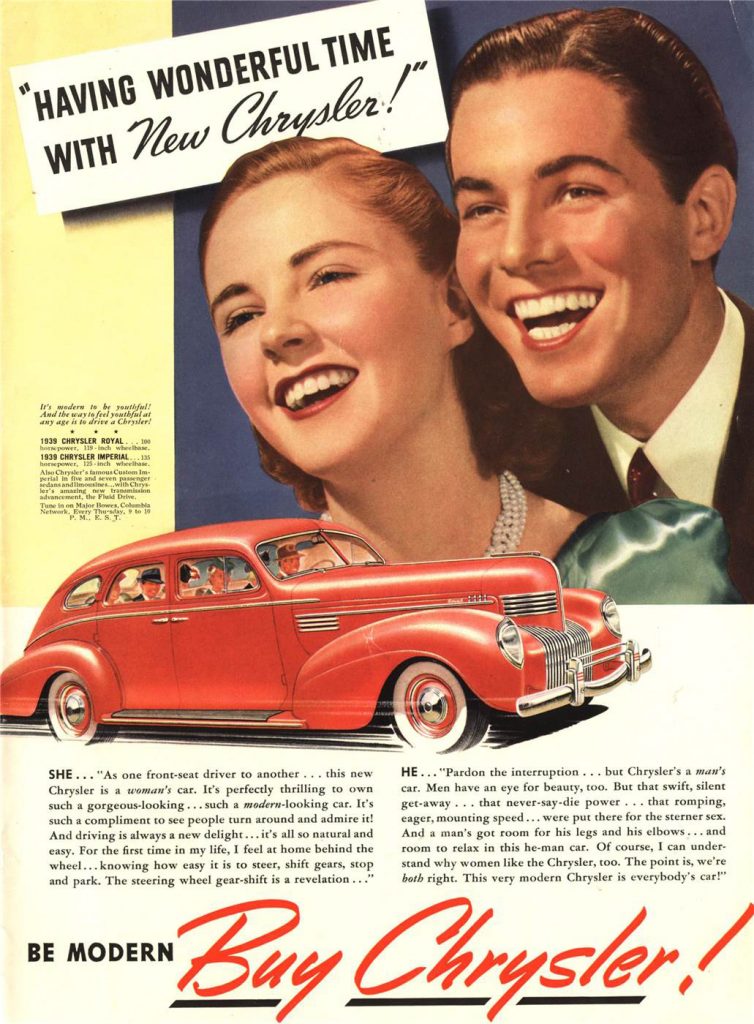
This 1930s Chrysler ad is the perfect example of reinforcing gender roles through media, and advertising. The ad uses highly gendered language for advertising the car to both “she” and “he”. Beginning with the woman-centered approach, the ad states “For the first time in my life, I feel at home behind the wheel”. The generalization that women aren’t good drivers is used to subjugate women and justify their subordination based on the fact that they are not as capable as men. The excerpt titled “She” also calls the car “gorgeous looking”. These two quotes are also based on patriarchal ideas of women’s obsession with personal appearance and beauty. Beauty is essential to the patriarchal standard of a woman. Enforcing very strict beauty standards has always been a tactic used to subjugate and demean used by the patriarchy.
Contrarily the “He” section of the ad is an ode to masculine strength and power. It reads “that swift, silent getaway… that never-say-die power… that romping. eager, mounting speed… were put there for the sterner sex.” This quote is attempting to appeal to men’s sense of masculine dominance. The ad uses physical language such as “swift” “romping” and “speed” to affirm the patriarchal idea of men’s physical superiority.
Advertising particularly aimed toward men and women preys on people’s endless strive to fulfill their prescribed gender role, in order to sell them material goods.

I also looked at a vintage advertisement in my post. They’re perfect representations of how the proper performance of gender is enforced through media and consumption. I like that you tied in consumerism to your post, which is something I didn’t think to do in mine. I definitely think that gender studies and consumerism are linked really closely; capitalism encourages strict boundaries around gender because if people believe they will be ostracized for not performing their gender correctly, they are more likely to buy things that correspond with their assigned gender to fit societal expectations. I think your post could have addressed your chosen theory more clearly and why it is important to examine advertising/consumer goods through a gender studies lens.
I thought your post on advertising was a great way to show how gender norms are perpetuated by society. I think the use of specific quotes from the advertisement itself strengthened your argument. I agree with Emily and think you could have been more clear with the overall theory you were using. I think you had strong evidence but just needed a topic or concluding statement to introduce the theory and tie it all back together. I also liked the reference to consumption in regards to gender studies at the end.
I really liked how you focused on how both the male and female role was being influenced by this advertisement. The only critict I would have is that the post could have had why it was important to look at these advertisements through the perspective of gender studies.
With the advertisement being plastered front and center, the post does a great job of grabbing a reader’s attention, and the reader is not disappointed by the content that follows. Lines drawn directly from the advertisement strongly illustrate points made about gender roles and norms in media–particularly in advertising media. A comprehensive blend of formalist close-reading of the source, combined with the lens of the gender theorist results in a well-supported argument. As others have said, making it more explicit why a gender studies/theory lens was used and why that’s important could strengthen the piece, though with a limited word count it’s understandable to have difficulties expressing that all in a blog post.
I think the advertisement you chose does a really good job showing how absurd some of the accepted gender roles were in the past. You do a great job criticizing it, and its sad that there are still strongly gendered advertisement campaigns today (ads for trucks come to mind). I wish you would have addressed that the “His” part is seemingly written as an interruption of the “Her” part, I would have liked to hear what you thought about that.
This is a great advertisement to use! The contrast between the way men and women perceive this car is definitely based in stereotypes. I wish you could have gone into a little bit more detail in the conclusion. With more space, I think that would have been much easier to do. It would be interesting to see a whole short essay about this ad.